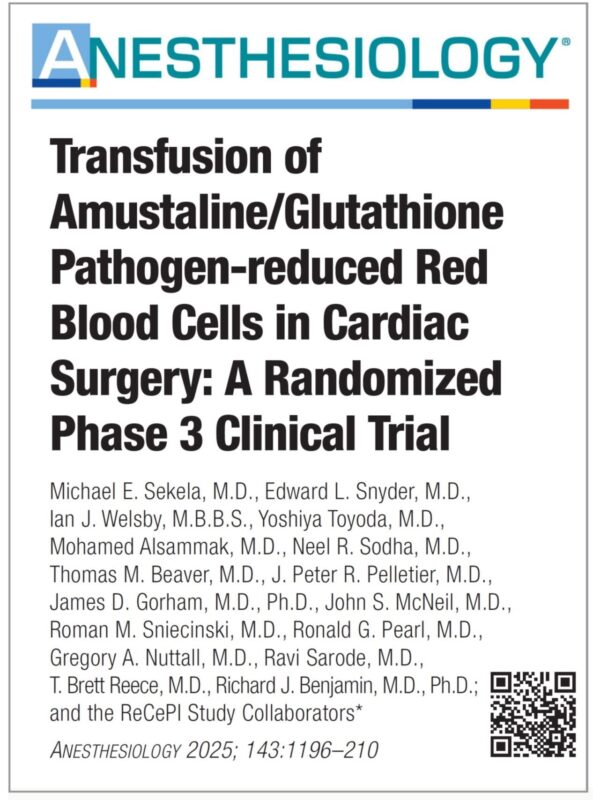
Richard Benjamin Shares Results of The ReCePI Phase III Clinical Study
Richard Benjamin, Chief Medical Officer at Cerus Corporation, shared on LinkedIn:
”The results of the ReCePI Phase III clinical study are now published.
A hearty congratulations to the many contributors and patients who have advanced the field of pathogen reduction for red blood cells (RBCs).
While transfusions are generally considered safe, they are always at risk for newly emerging infections (think historically of HIV, WNV, Zika, etc.) and for threats that are not covered by current testing (e.g., bacteria, malaria, etc.).
Technologies are FDA-approved to safeguard platelet and plasma transfusions, leaving an obvious gap with the most commonly transfused RBC components.
This work is bringing RBC pathogen reduction to reality and would not have been possible without generous funding from BARDA, a US agency with true foresight to protect patients against future and current threats to transfusion safety.”
Read the full article here.
Article: Transfusion of Amustaline/Glutathione Pathogen-reduced Red Blood Cells in Cardiac Surgery: A Randomized Phase 3 Clinical Trial
Authors: Michael E. Sekela, Edward L. Snyder, Ian J. Welsby, Yoshiya Toyoda, Mohamed Alsammak, Neel R. Sodha, Thomas M. Beaver, J. Peter R. Pelletier, James D. Gorham, John S. McNeil, Roman M. Sniecinski, Ronald G. Pearl, Gregory A. Nuttall, Ravi Sarode, T. Brett Reece, Richard Benjamin, and the ReCePI Study Collaborators

Stay updated on all scientific advances with Hemostasis Today.
-
Oct 23, 2025, 06:03Melanie Daniel: Wonderful Presentation on Emicizumab by Mickael Rosa at ECTH
-
Oct 22, 2025, 06:17We Will Continue to Raise Awareness and Remind Rveryone That Donating Blood Means Saving Lives - Yeolyan Hematology and Oncology Center
-
Oct 21, 2025, 06:59Samwel Mikaye: Polycythemia and the Risk of Blood Clots
-
Oct 21, 2025, 06:58Samuel Nweke: Interpreting D-Dimer Results
-
Oct 21, 2025, 05:20Ewa Fiorentino Rozek: APS - When “Unprovoked” Clots And Pregnancy Loss Connect
-
Oct 23, 2025, 06:48Omid Seidizadeh Shares Deep Molecular Modeling and Mechanistic Insights into Type 2A VWD
-
Oct 23, 2025, 06:45Mélanie Roussel on D-Dimer Thresholds for Diagnosis of Pulmonary Embolism
-
Oct 23, 2025, 06:28Ramya Ramakrishnan on IDA Association with Depression
-
Oct 23, 2025, 06:07Cedric Hermans: Von Willebrand Disease Diagnosis - From Complexity to Simplicity
-
Oct 23, 2025, 05:45Andrew Larry Frelinger III on Activation of Platelets in Flow Cytometry
-
Oct 23, 2025, 07:11Sebastien Lobet Presented the ACTIVLIM-Hemo Scale
-
Oct 23, 2025, 07:05Syed Ehsan Shah on Advantages of Werfen HemoCell Automation
-
Oct 22, 2025, 08:25Johanna Nystedt: Not Every Day We Can Release a New Blood Product to Meet An Unmet Medical Need!
-
Oct 21, 2025, 06:58Arno Nierich: How Caffeine Affects Red Blood Cells and Blood Storage
-
Oct 21, 2025, 06:43Could Gene Therapy Offer Lasting Quality of Life for People with Hemophilia B?
-
Oct 23, 2025, 06:52Louise Bannon: Thrilled to Witness The Incredible Reach of This Year's World Thrombosis Day!
-
Oct 23, 2025, 06:50Caitlin Raymond to Speak at The 11th Annual Bloodless Medicine and Surgery Society Conference
-
Oct 22, 2025, 10:46Conversation with Ferran Nadeu – Touch Haematology Future Leader 2025
-
Oct 22, 2025, 10:32Lynn Malec - The New Director of the CCBD and Pharmacy at Children's Wisconsin
-
Oct 22, 2025, 09:41Deanna Joseph: Feeling Inspired and Deeply Grateful After Attending the 2025 HTRS SEARCH Workshop
